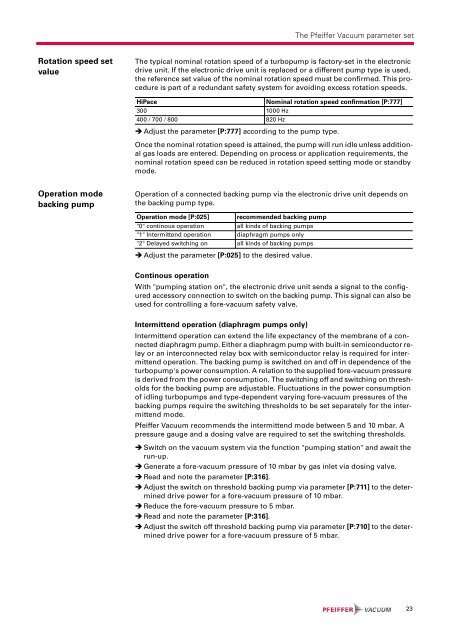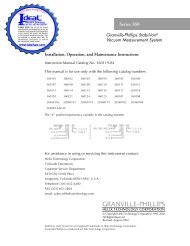Pfeiffer, TC 400, Electronic Drive Unit, Operating_Instructions
Pfeiffer, TC 400, Electronic Drive Unit, Operating_Instructions
Pfeiffer, TC 400, Electronic Drive Unit, Operating_Instructions
You also want an ePaper? Increase the reach of your titles
YUMPU automatically turns print PDFs into web optimized ePapers that Google loves.
The <strong>Pfeiffer</strong> Vacuum parameter set<br />
Rotation speed set<br />
value<br />
The typical nominal rotation speed of a turbopump is factory-set in the electronic<br />
drive unit. If the electronic drive unit is replaced or a different pump type is used,<br />
the reference set value of the nominal rotation speed must be confirmed. This procedure<br />
is part of a redundant safety system for avoiding excess rotation speeds.<br />
HiPace<br />
Nominal rotation speed confirmation [P:777]<br />
300 1000 Hz<br />
<strong>400</strong> / 700 / 800 820 Hz<br />
Adjust the parameter [P:777] according to the pump type.<br />
Once the nominal rotation speed is attained, the pump will run idle unless additional<br />
gas loads are entered. Depending on process or application requirements, the<br />
nominal rotation speed can be reduced in rotation speed setting mode or standby<br />
mode.<br />
Operation mode<br />
backing pump<br />
Operation of a connected backing pump via the electronic drive unit depends on<br />
the backing pump type.<br />
Operation mode [P:025] recommended backing pump<br />
"0" continous operation all kinds of backing pumps<br />
"1" Intermittend operation diaphragm pumps only<br />
"2" Delayed switching on all kinds of backing pumps<br />
Adjust the parameter [P:025] to the desired value.<br />
Continous operation<br />
With "pumping station on", the electronic drive unit sends a signal to the configured<br />
accessory connection to switch on the backing pump. This signal can also be<br />
used for controlling a fore-vacuum safety valve.<br />
Intermittend operation (diaphragm pumps only)<br />
Intermittend operation can extend the life expectancy of the membrane of a connected<br />
diaphragm pump. Either a diaphragm pump with built-in semiconductor relay<br />
or an interconnected relay box with semiconductor relay is required for intermittend<br />
operation. The backing pump is switched on and off in dependence of the<br />
turbopump's power consumption. A relation to the supplied fore-vacuum pressure<br />
is derived from the power consumption. The switching off and switching on thresholds<br />
for the backing pump are adjustable. Fluctuations in the power consumption<br />
of idling turbopumps and type-dependent varying fore-vacuum pressures of the<br />
backing pumps require the switching thresholds to be set separately for the intermittend<br />
mode.<br />
<strong>Pfeiffer</strong> Vacuum recommends the intermittend mode between 5 and 10 mbar. A<br />
pressure gauge and a dosing valve are required to set the switching thresholds.<br />
Switch on the vacuum system via the function "pumping station" and await the<br />
run-up.<br />
Generate a fore-vacuum pressure of 10 mbar by gas inlet via dosing valve.<br />
Read and note the parameter [P:316].<br />
Adjust the switch on threshold backing pump via parameter [P:711] to the determined<br />
drive power for a fore-vacuum pressure of 10 mbar.<br />
Reduce the fore-vacuum pressure to 5 mbar.<br />
Read and note the parameter [P:316].<br />
Adjust the switch off threshold backing pump via parameter [P:710] to the determined<br />
drive power for a fore-vacuum pressure of 5 mbar.<br />
23
















